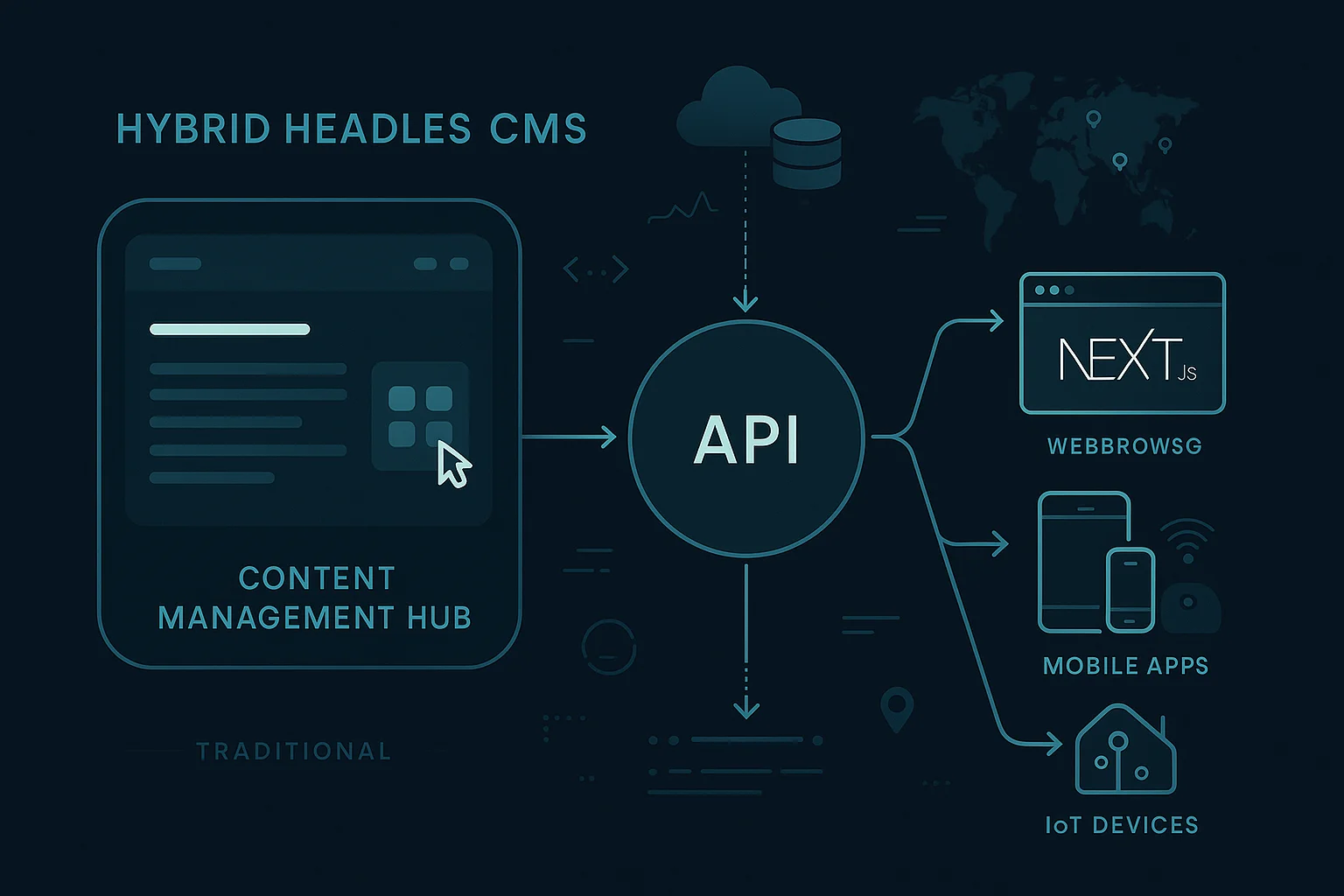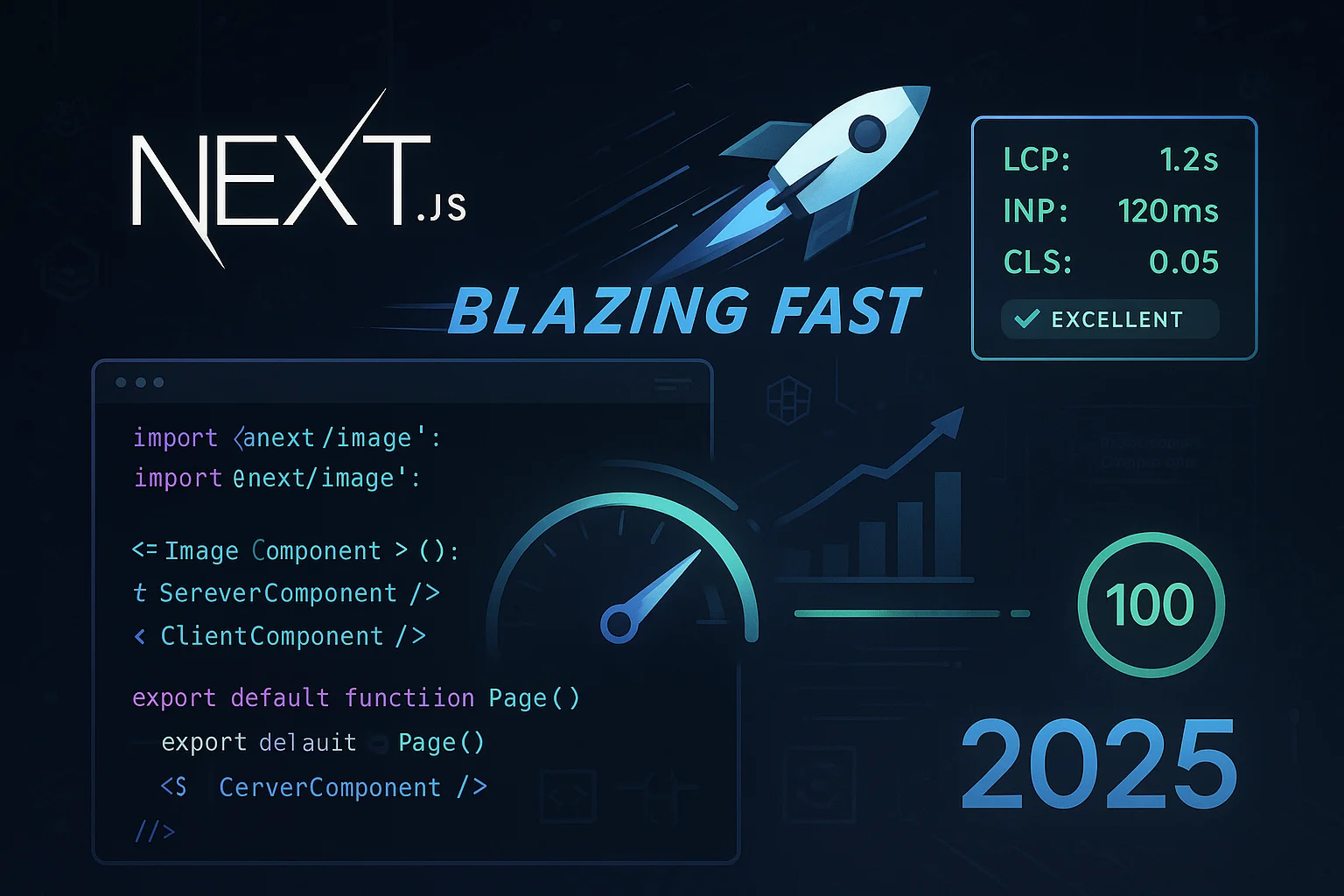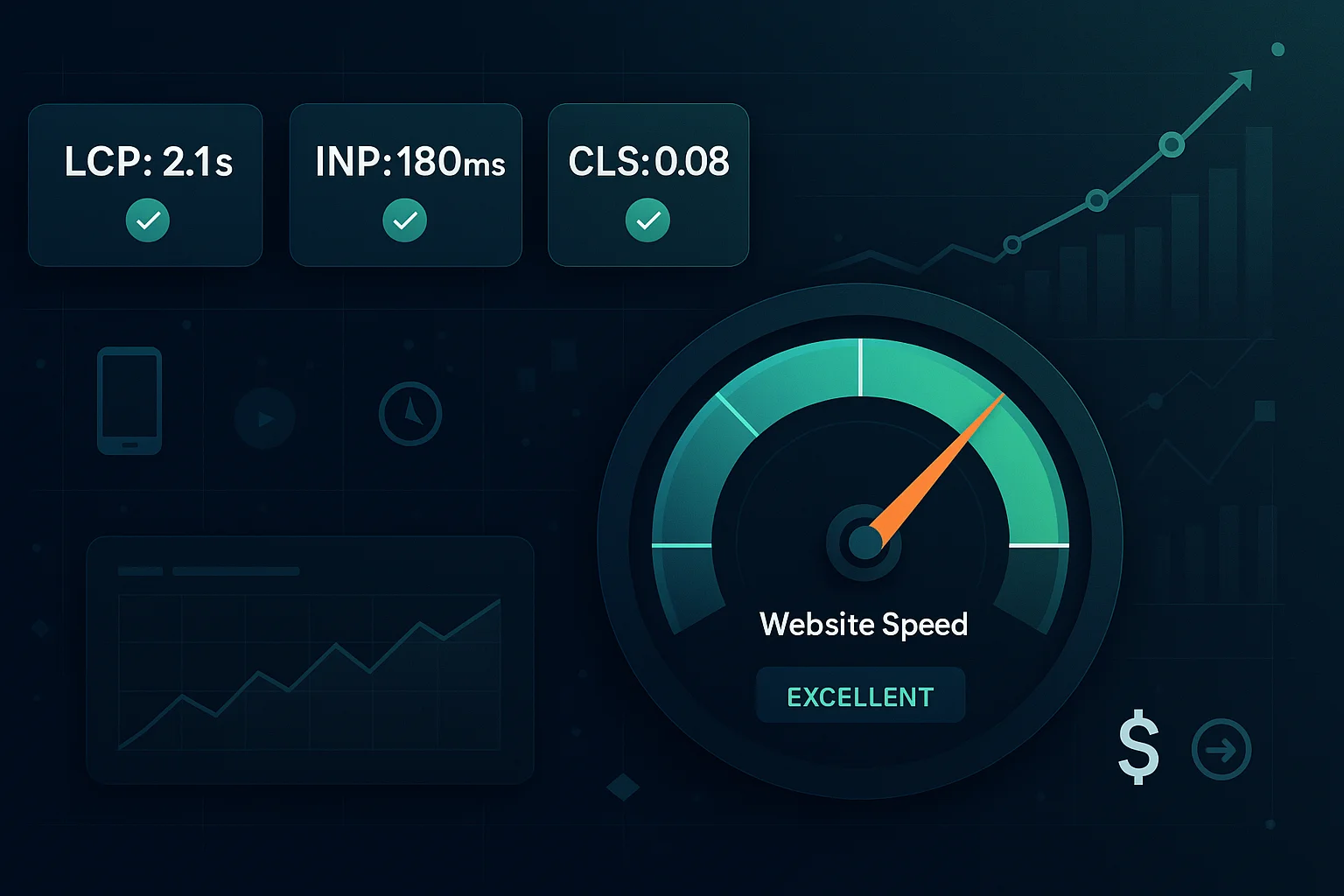
Hybrid Headless CMS: The Future of Content Management
In the rapidly evolving landscape of content management, traditional monolithic CMS platforms are increasingly showing their limitations. Meanwhile, pure headless solutions, while powerful, often leave content editors feeling lost without familiar editing interfaces. Enter hybrid headless CMS architecture - the perfect synthesis that's reshaping how enterprises approach content management in 2024 and beyond.
The Evolution of Content Management
The Traditional CMS Era
For over two decades, traditional CMS platforms like WordPress, Drupal, and Joomla dominated the web. These monolithic systems tightly coupled content creation, management, and presentation layers, providing:
- WYSIWYG editors that content creators loved
- Built-in themes and templating for quick setup
- Plugin ecosystems for extended functionality
- All-in-one solutions that handled everything from content to hosting
However, as digital experiences became more complex and multi-channel, these systems began showing cracks:
- Performance limitations due to server-side rendering
- Scalability challenges with high traffic loads
- Developer constraints in building custom experiences
- Security vulnerabilities from coupled architecture
- Mobile-first limitations in an increasingly mobile world
The Headless Revolution
The rise of headless CMS solutions promised to solve these issues by decoupling content management from presentation:
- API-first architecture enabling omnichannel delivery
- Better performance through static site generation
- Developer freedom to use any frontend technology
- Enhanced security with reduced attack surface
- Scalability through CDN distribution
But this approach introduced new challenges:
- Content editor experience suffered without visual editing
- Preview capabilities became complex to implement
- Higher technical barriers for non-technical users
- Increased development complexity for simple sites
What is Hybrid Headless CMS?
A hybrid headless CMS represents the evolution beyond the traditional headless vs. traditional debate. It combines the content management excellence of traditional CMSs with the delivery flexibility of headless architectures.
Core Characteristics
Dual Architecture Support:
- Traditional coupled rendering for content editing and preview
- Headless API delivery for production frontends
- Seamless switching between modes based on context
Content-First Design:
- Rich content editing experiences with visual feedback
- Advanced content modeling and relationships
- Workflow management and content governance
- Real-time collaboration features
Developer-Friendly APIs:
- RESTful and GraphQL APIs for flexible content delivery
- Webhook support for real-time updates
- SDKs and tools for popular frameworks
- Comprehensive documentation and developer resources
Performance Optimization:
- Built-in CDN integration and edge caching
- Static site generation support
- Image optimization and asset management
- Core Web Vitals optimization out of the box
Architecture Comparison
Rendering diagram...
Key Benefits in Detail
1. Superior Content Editor Experience
Visual Content Creation: Modern hybrid CMSs provide rich visual editors that rival traditional platforms:
React JSX// Example: Real-time preview component const ContentPreview = ({ content, isEditing }) => { return ( <div className={`preview-container ${isEditing ? 'editing' : 'live'}`}> {isEditing && <EditingOverlay />} <RichTextRenderer content={content.body} /> <ComponentRenderer components={content.components} /> </div> ) }
Advanced Content Modeling:
- Flexible content types with custom fields
- Relationship management between content pieces
- Content validation and quality checks
- Version control and content history
Collaborative Workflows:
- Multi-user editing with real-time collaboration
- Editorial workflows with approval processes
- Content scheduling and publishing controls
- Role-based permissions and access control
2. Performance Excellence
Static Site Generation (SSG): Hybrid headless CMSs excel at powering static sites with dynamic content capabilities:
React JSX// Enhanced SSG with incremental regeneration export async function getStaticProps({ params, preview = false }) { const content = await fetchContentFromCMS(params.slug, { preview, includeRelated: true, optimizeImages: true }) if (!content) { return { notFound: true } } return { props: { content, preview }, revalidate: preview ? 1 : 3600, // Hourly updates in production } } // Enhanced path generation with prioritization export async function getStaticPaths() { const paths = await getAllContentPaths({ limit: 1000, // Pre-generate top 1000 pages priority: 'high' // Focus on high-traffic content }) return { paths, fallback: 'blocking', // Generate other pages on-demand } }
Edge Computing Integration:
- Content delivery through global CDN networks
- Edge-side includes (ESI) for dynamic content injection
- Serverless function integration for real-time features
- Automatic image optimization and WebP conversion
Core Web Vitals Optimization:
- Lazy loading for images and components
- Critical CSS extraction and inlining
- Resource hints and preloading strategies
- Bundle optimization and code splitting
3. Scalability and Reliability
Infrastructure Scaling:
- Automatic scaling based on traffic patterns
- Database optimization for read-heavy workloads
- Redis caching for frequently accessed content
- Multi-region deployment for global performance
Content Delivery Optimization:
React JSX// Advanced caching strategy const cacheConfig = { // Static content - long cache static: { maxAge: 31536000, // 1 year staleWhileRevalidate: 86400 // 1 day }, // Dynamic content - shorter cache with revalidation dynamic: { maxAge: 3600, // 1 hour staleWhileRevalidate: 300, // 5 minutes tags: ['content', 'user-specific'] } }
Implementation Strategies
Content Publishing Workflow
Rendering diagram...
Advanced Next.js Integration
Incremental Static Regeneration (ISR):
React JSX// pages/blog/[slug].js import { getCMSContent, getAllSlugs } from '../lib/cms' export default function BlogPost({ post, relatedPosts }) { return ( <article> <Header post={post} /> <ContentRenderer content={post.content} /> <RelatedPosts posts={relatedPosts} /> <Comments postId={post.id} /> </article> ) } export async function getStaticProps({ params, preview = false }) { const [post, relatedPosts] = await Promise.all([ getCMSContent('posts', params.slug, { preview }), getCMSContent('posts', null, { related: params.slug, limit: 3 }) ]) return { props: { post, relatedPosts }, revalidate: preview ? 1 : 3600, notFound: !post } }
Dynamic Content Islands:
React JSX// components/DynamicContent.js import { useEffect, useState } from 'react' import { fetchLiveData } from '../lib/api' export default function DynamicContentIsland({ contentId, fallback }) { const [liveData, setLiveData] = useState(fallback) const [loading, setLoading] = useState(false) useEffect(() => { const updateContent = async () => { setLoading(true) try { const fresh = await fetchLiveData(contentId) setLiveData(fresh) } finally { setLoading(false) } } // Update content every 5 minutes const interval = setInterval(updateContent, 300000) return () => clearInterval(interval) }, [contentId]) return ( <div className={`content-island ${loading ? 'updating' : ''}`}> <ContentRenderer data={liveData} /> {loading && <UpdateIndicator />} </div> ) }
API Design Patterns
GraphQL Integration:
GRAPHQL# Enhanced GraphQL schema type Article { id: ID! title: String! slug: String! content: RichText! author: Author! categories: [Category!]! tags: [Tag!]! publishedAt: DateTime updatedAt: DateTime seoData: SEOData relatedArticles(limit: Int = 3): [Article!]! } query GetArticle($slug: String!, $preview: Boolean = false) { article(slug: $slug, preview: $preview) { id title content author { name avatar bio } seoData { title description ogImage } relatedArticles { id title slug excerpt } } }
Leading Hybrid Headless Solutions
1. Contentful
Strengths:
- Industry-leading developer experience
- Robust CDN with global edge locations
- Excellent GraphQL API with real-time capabilities
- Rich ecosystem of integrations
Best For: Medium to large enterprises requiring global content delivery
Pricing: Starts at $489/month for teams
2. Strapi
Strengths:
- Open-source flexibility with enterprise options
- Self-hosted or cloud deployment options
- Plugin architecture for custom functionality
- Developer-friendly with extensive customization
Best For: Development teams wanting full control and customization
Pricing: Free open-source, Enterprise from $1000/month
3. Sanity
Strengths:
- Real-time collaborative editing
- Highly customizable Studio interface
- Powerful query language (GROQ)
- Excellent performance and developer tools
Best For: Content-heavy applications requiring real-time collaboration
Pricing: Pay-as-you-go starting at $99/month
4. Drupal with JSON:API
Strengths:
- Enterprise-grade security and scalability
- Mature content management features
- Extensive module ecosystem
- Strong community support
Best For: Large enterprises with complex content requirements
Pricing: Open-source with hosting and support costs
5. WordPress with REST API
Strengths:
- Familiar editing experience for content creators
- Massive plugin ecosystem
- Cost-effective for smaller projects
- Easy migration from existing WordPress sites
Best For: Organizations with existing WordPress expertise
Pricing: Free software with hosting costs
Comprehensive Migration Strategy
Phase 1: Discovery and Planning
Milestone: Complete comprehensive audit and establish project foundation
Content Audit:
Bash# Example content analysis script #!/bin/bash echo "Analyzing content structure..." # Count content types echo "Content Types:" mysql -u user -p database -e " SELECT post_type, COUNT(*) as count FROM wp_posts WHERE post_status = 'publish' GROUP BY post_type" # Analyze content relationships echo "Content Relationships:" mysql -u user -p database -e " SELECT meta_key, COUNT(*) as usage FROM wp_postmeta GROUP BY meta_key ORDER BY usage DESC LIMIT 20"
Technical Assessment:
- Current performance metrics baseline
- SEO ranking analysis
- User behavior analytics review
- Infrastructure cost analysis
Stakeholder Interviews:
- Content editor workflow analysis
- Developer pain point identification
- Business requirement gathering
- Success criteria definition
Phase 2: Architecture Design
Milestone: Finalize technical architecture and integration specifications
System Architecture:
Rendering diagram...
Content Model Design:
- Entity relationship mapping
- API endpoint planning
- Caching strategy definition
- Security and permission modeling
Phase 3: Development and Implementation
Milestone: Deploy fully functional hybrid CMS with content migration complete
Environment Setup:
JavaScript// next.config.js const nextConfig = { images: { domains: ['cdn.contentful.com', 'images.ctfassets.net'], formats: ['image/webp', 'image/avif'], }, experimental: { isrMemoryCacheSize: 0, // Disable ISR memory cache in production }, env: { CMS_API_URL: process.env.CMS_API_URL, CMS_API_KEY: process.env.CMS_API_KEY, PREVIEW_SECRET: process.env.PREVIEW_SECRET, }, async headers() { return [ { source: '/api/:path*', headers: [ { key: 'Cache-Control', value: 's-maxage=3600, stale-while-revalidate' }, ], }, ] }, } module.exports = nextConfig
Content Migration:
JavaScript// scripts/migrate-content.js const migrateContent = async () => { const oldContent = await fetchFromOldCMS() for (const item of oldContent) { const transformedItem = { title: item.title, slug: item.slug, content: await transformRichText(item.content), author: await mapAuthor(item.author_id), categories: await mapCategories(item.categories), publishedAt: new Date(item.published_date), seoData: { title: item.meta_title || item.title, description: item.meta_description || generateExcerpt(item.content), ogImage: await migrateImage(item.featured_image) } } await createInNewCMS(transformedItem) console.log(`Migrated: ${item.title}`) } }
Phase 4: Testing and Optimization
Milestone: Achieve production-ready performance and launch readiness
Performance Testing:
- Load testing with realistic traffic patterns
- Core Web Vitals measurement and optimization
- SEO impact assessment
- Cross-device and browser testing
User Acceptance Testing:
- Content editor training and feedback
- Workflow optimization
- Permission and security testing
- Integration testing with existing systems
Phase 5: Launch and Monitoring (Ongoing)
Milestone: Successful production launch with continuous monitoring and optimization
Deployment Strategy:
YAML# .github/workflows/deploy.yml name: Deploy to Production on: push: branches: [main] # Trigger on CMS content changes repository_dispatch: types: [content-update] jobs: deploy: runs-on: ubuntu-latest steps: - uses: actions/checkout@v3 - name: Setup Node.js uses: actions/setup-node@v3 with: node-version: '18' cache: 'npm' - name: Install dependencies run: npm ci - name: Build application run: npm run build env: CMS_API_URL: ${{ secrets.CMS_API_URL }} CMS_API_KEY: ${{ secrets.CMS_API_KEY }} - name: Deploy to Vercel run: npx vercel --prod --token ${{ secrets.VERCEL_TOKEN }}
Monitoring and Analytics:
- Real-time performance monitoring
- Content delivery metrics
- User experience analytics
- Business impact measurement
Advanced Use Cases
Multi-tenant Architecture
JavaScript// lib/tenant-resolver.js export const resolveTenant = (req) => { const hostname = req.headers.host const subdomain = hostname.split('.')[0] return { id: subdomain, config: getTenantConfig(subdomain), theme: getTenantTheme(subdomain), content: getTenantContent(subdomain) } } // pages/[...slug].js export async function getServerSideProps({ req, params }) { const tenant = resolveTenant(req) const content = await fetchTenantContent(tenant.id, params.slug) return { props: { content, tenant } } }
Internationalization (i18n)
JavaScript// lib/i18n-content.js export const getLocalizedContent = async (slug, locale = 'en') => { const content = await cms.getEntry(slug, { locale }) // Fallback to default locale if content not available if (!content && locale !== 'en') { return await cms.getEntry(slug, { locale: 'en' }) } return content } // Automatic locale detection export const detectLocale = (req) => { const acceptLanguage = req.headers['accept-language'] const supportedLocales = ['en', 'es', 'fr', 'de'] return acceptLanguage .split(',') .map(lang => lang.split(';')[0].trim()) .find(lang => supportedLocales.includes(lang)) || 'en' }
Security Considerations
API Security
JavaScript// middleware/auth.js export const authenticateAPI = async (req, res, next) => { const token = req.headers.authorization?.replace('Bearer ', '') if (!token) { return res.status(401).json({ error: 'Authentication required' }) } try { const decoded = jwt.verify(token, process.env.JWT_SECRET) req.user = decoded next() } catch (error) { return res.status(401).json({ error: 'Invalid token' }) } } // Rate limiting export const rateLimiter = rateLimit({ windowMs: 15 * 60 * 1000, // 15 minutes max: 100, // Limit each IP to 100 requests per windowMs message: 'Too many requests from this IP' })
Content Security
JavaScript// lib/content-validation.js export const validateContent = (content) => { // Sanitize HTML content const clean = DOMPurify.sanitize(content, { ALLOWED_TAGS: ['p', 'h1', 'h2', 'h3', 'strong', 'em', 'ul', 'ol', 'li'], ALLOWED_ATTR: ['href', 'title', 'alt'] }) // Validate required fields if (!content.title || content.title.length < 3) { throw new Error('Title is required and must be at least 3 characters') } return clean }
Future Trends and Considerations
AI-Powered Content Management
- Automated content tagging and categorization
- AI-generated meta descriptions and SEO optimization
- Content performance prediction and optimization
- Automated content translation and localization
Edge Computing Evolution
- Edge-side personalization without sacrificing performance
- Real-time content updates through edge computing
- Advanced caching strategies with edge intelligence
- Serverless functions for dynamic content processing
Web3 and Decentralized Content
- Blockchain-based content verification
- Decentralized content storage and delivery
- NFT integration for digital content ownership
- Community-driven content governance models
Conclusion
Hybrid headless CMS architecture represents the maturation of content management technology, offering the perfect balance between content creator experience and technical flexibility. As we move forward in 2024, organizations that adopt this approach will be better positioned to deliver exceptional digital experiences while maintaining the agility to adapt to future technological changes.
The key to success lies not just in choosing the right technology stack, but in thoughtful planning, gradual migration, and continuous optimization. By following the strategies outlined in this guide, you can build a content management system that serves both your content creators and your technical team effectively.
Whether you're managing a corporate website, an e-commerce platform, or a content-heavy application, hybrid headless CMS offers the scalability, performance, and flexibility needed to compete in today's digital landscape. The future of content management is here, and it's hybrid.
Ready to start your hybrid headless journey? Contact our team for a personalized consultation and migration strategy tailored to your specific needs.
Related Posts

Drupal's Identity Crisis is Exhausting - and Exactly Why It Still Works
Everyone wants Drupal to pick a lane. CMS? Framework? Application platform? The community's been wrestling with this mess for years, and right now it's more confusing than ever.

Next.js Performance Optimization: The Complete 2025 Guide
Master advanced Next.js 15+ performance techniques including React Server Components, streaming, and Core Web Vitals optimization for lightning-fast applications.

Web Performance Metrics That Actually Matter in 2025
Navigate the evolving landscape of web performance with Core Web Vitals updates, INP transition, and business-critical metrics that drive real results.

